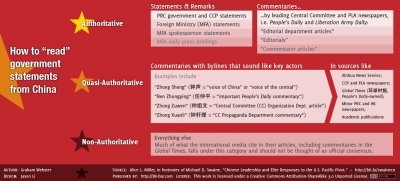Decoding the ‘voice of China’ through media reports
As U.S. Secretary of State Hillary Clinton wraps up meetings today in Beijing, it’s hard to say how her most recent Asia-Pacific trip has gone. And that’s partly because interpreting media reports from the Chinese side is more art than science.
When Clinton was in the Cook Islands, Voice of America captured media consensus with the headline “U.S. And China Soften the Rhetoric.” Then most reports changed tone. The New York Times reported that Clinton met a “barrage of unusually harsh coverage in China’s official news media,” an impression based on, among others, an editorial from the Global Times that went after Clinton directly, and a signed Xinhua commentary that reportedly criticized the U.S. “role as a sneaky troublemaker sitting behind some nations in the region and pulling strings.”
What do we make of this? For much of the second half of the 20th century, foreign observers depended on the art of the so-called “pekingology” (similar to kremlinology): watching for signals in official media and elsewhere to understand opaque elite politics. There are many more information sources now, including online; and to some extent, the Chinese government is simply more transparent. Moreover, foreign observers (including myself once again as of this week) now routinely work from inside China. Numerous official and track 2 dialogues between China and other countries allow direct contact and conversation.
But there is still an art to interpreting commentary that ranges from diplomatic and conciliatory to strident and nationalistic, from reform-minded internationalism to familiar anti-imperialism. The common thread between Mao-era pekingology and 21st century analysis is judging authoritativeness.
Luckily, Alice L. Miller of the Hoover Institution at Stanford offers some guidelines. Miller has some experience—she was a CIA analyst on China and East Asia from 1974 to 1990. Miller’s insight comes, of all places, in a footnote in a paper by Michael D. Swaine. Miller divides various types of sources into “authoritative,” “quasi-authoritative,” and “non-authoritative”—in this case on the U.S. “pivot” or “rebalance” to the Asia-Pacific. With the help of 88 Bar’s Jason Li, here is a visualization of key guidelines for reading government voices.

There are of course caveats. Miller and Swaine in this piece are concerned with international politics with the United States, not domestic issues, and the lists are by no means complete. But the key insight—that not all “government” publications or comments are created equal—is broadly applicable, perhaps even outside the context of China-watching.
Perhaps the most interesting thing here is the phenomenon of “quasi-authoritative” commentaries under bylines that are not people’s names, but rather homophones for whatever they are supposed to represent. One recently emerged prominent byline is “Zhong Sheng” (钟声), which sounds like “voice of the central” (per Swaine) or “voice of China” (per several others), and Swaine remarks that comments under the byline “[appear] to be written by the editorial staff of the People’s Daily International Department.”
Compared with signed commentaries by individual scholars, this form of comment is thought to be produced by a team and in a way that more directly represents the paper, without running directly under the paper’s name. Zhong Sheng, as it turns out, has been the source of pointed but comparatively sober commentary on the United States and Japan—far more tempered than signed commentaries by outside scholars.
The position of the Global Times is also important. On this source, frequently quoted as a voice of the more nationalistic sector of the Chinese body politic, Miller is especially cautious. In another Swaine footnote, she argues: “Despite the view expressed by some pundits, nothing published in the Global Times is ‘authoritative’ in any meaningful sense, ‘because the newspaper is a commercial vehicle and doesn’t stand for the People’s Daily, even though it is subordinate to that organ.'”
So, the next time you read an article quoting a commentary in the Global Times as a sign that “China” is escalating rhetoric on some international issue, consider what that actually represents, and look for other voices higher on the authority scale for interpretations closer to top decision makers. On Clinton’s trip to Asia, consider that the softer rhetoric came from Vice Foreign Minister Cui Tiankai, and the more caustic came from the Global Times. If we follow Miller, it’s clear who we should trust as a voice of China’s top leaders; even if Cui and the Foreign Ministry have limited power, they are still more authoritative than a mass market newspaper editorial.
3 comments on “Decoding the ‘voice of China’ through media reports”